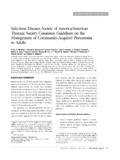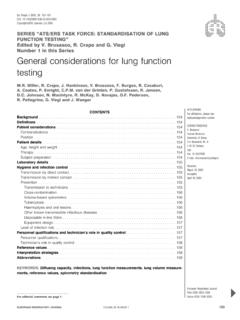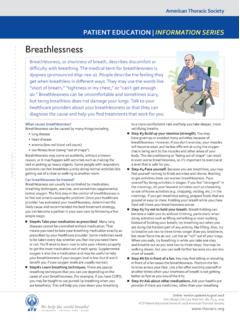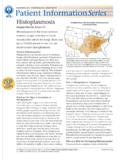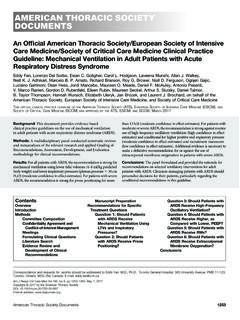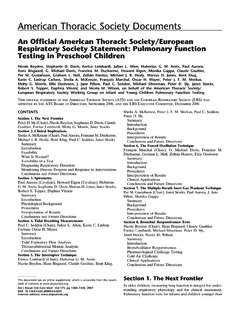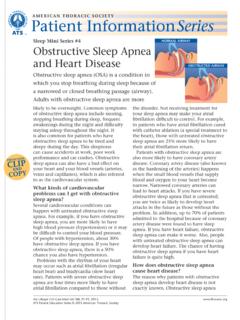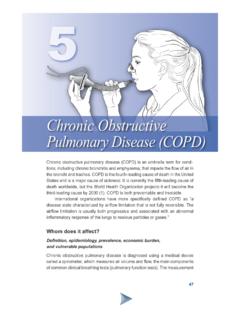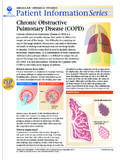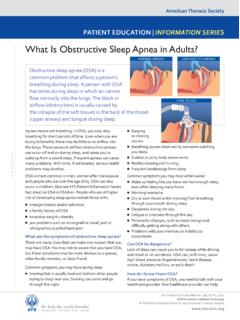Transcription of PATIENT EDUCATION | INFORMATION SERIES
1 american thoracic SocietyPATIENT EDUCATION | INFORMATION SERIESCLIP AND COPYLung function tests can be used to: Compare your lung function with known standards that show how well your lungs should be working. Measure the effect of chronic diseases like asthma, chronic obstructive lung disease (COPD), or cystic fibrosis on lung function. Identify early changes in lung function that might show a need for a change in treatment. Detect narrowing in the airways. Decide if a medicine (such as a bronchodilator) could be helpful to use. Show whether exposure to substances in your home or workplace may have harmed your lungs. Determine your ability to tolerate surgery and medical get the most accurate results from your breathing tests: Do not smoke for at least 1 hour before the test. Do not drink alcohol for at least 4 hours before the test. Do not exercise heavily for at least 30 minutes before the test. Do not wear tight clothing that makes it difficult for you to take a deep breath.
2 Do not eat a large meal within 2 hours before the test. Ask your health care provider if there are any medicines that you should not take on the day of your is spirometry?Spirometry is one of the most commonly ordered tests of your lung function. The spirometer measures how much air you can breathe into your lungs and how much air you can quickly blow out of your lungs. This test is done by having you take in a deep breath and then, as fast as you can, blow out all of the air. You will be blowing into a tube connected to a machine (spirometer). To get the best test result, the test is repeated three times. You will be given a rest between test is often repeated after giving you a breathing medicine (bronchodilator) to find out how much better you might breathe with this type of medicine. It can take practice to be able to do a spirometry test well. The staff person will work with you to learn how to do the test usually takes 30 minutes to complete this should I know before doing a spirometry test?
3 You may be asked not to take your breathing medicines before this test. Instructions will be given on how to do this test. If you do not understand the instructions, ask the staff to repeat them. It takes effort to do this test and you may become tired. This is expected. If you become light-headed or dizzy during this test, immediately stop blowing and let the staff are diffusion studies?Diffusion tests find out how well the oxygen in the air you breathe in moves from your lungs into your blood. Pulmonary Function TestsPulmonary function tests (PFT s) are breathing tests to find out how well you move air in and out of your lungs and how well oxygen enters your blood stream. The most common PFT s are spirometry (spy-RAH-me-tree), diffusion studies, and body plethysmography (ple-thiz-MA-gra-fee). Sometimes only one test is done, other times all tests will be scheduled on the same J Respir Crit Care Med, Vol. 189, P17-P18, 2014 Online Version Updated October 2019 ATS PATIENT EDUCATION SERIES 2014 american thoracic SocietyAmerican thoracic SocietyPATIENT EDUCATION | INFORMATION spirometry, this test is done by having you breathe into a mouthpiece connected to a machine.
4 You will be asked to empty your lungs by gently breathing out as much air as you can. Then you will breathe in a quick (but deep breath), hold your breath for 10 seconds, and then breathe out as instructed. You will do the test several times. It usually takes about 30 minutes to complete this should I know before doing a diffusion test? Do not smoke and stay away from others who are smoking on the day of the test. If you are on oxygen, you will usually be asked to be off oxygen for a few minutes before taking this is body plethysmography?Body plethysmography is a test to find out how much air is in your lungs after you take in a deep breath, and how much air is left in your lungs after breathing out as much as you can. No matter how hard you try, you can never get all of the air out of your lungs. Measuring the total amount of air your lungs can hold and the amount of air left in your lungs after you breathe out gives your healthcare provider INFORMATION about how well your lungs are working and helps guide your treatment.
5 This test requires that you sit in box with large windows (like a telephone booth) that you can see through. You will be asked to wear a nose clip and you will be given instructions on how to breathe through the mouthpiece. You will be asked to take short, shallow breaths through the mouthpiece when it is blocked for a few seconds, which may be uncomfortable. If you have difficulty with being in closed spaces (claustrophobia), mention this to your provider ordering the test. This will avoid any misunderstanding and discomfort to you. It usually takes about 15 minutes to complete. Some PFT labs will use other tests instead of plethysmography to measure the total volume of air in your should I know before doing a plethysmography test? If you are on oxygen, you will usually be asked to be off oxygen during this test. Let the staff know if you have difficulty in closed are normal results for lung function tests?Because everyone s body and lungs are different sizes, normal results differ from person to instance, taller people and males tend to have larger lungs whereas shorter people and females have smaller lungs.
6 It is normal for your lung function to fall slightly as you standards that your healthcare provider uses, are based on your height, age, and sex at birth. These numbers are called the predicted values . Your measured values will be compared to these predicted values. Authors: Bonnie Fahy, RN, MN; Marianna Sockrider, MD, DrPH; Suzanne Lareau, RN, MS Updated: Marianna Sockrider MD, DrPH Reviewers: Brian Graham PhD, David Kaminsky MDThis INFORMATION is a public service of the american thoracic society . The content is for educational purposes only. It should not be used as a substitute for the medical advice of one s healthcare ResourcesAmerican thoracic society Lung Association Lung Health EDUCATION Program A ction Steps Ask questions if you do not understand the instructions for the lung function test. If you have a cold or flu, let the test center know because you may need to reschedule your test. If you have difficulty with closed spaces (claustrophobia), let the test center know in case one of the tests involves being enclosed.
7 Ask if there are any medicines you should stop taking before being tested and for how long you should stop it. After your pulmonary function testing is over, you can return to your normal Provider s Contact Number.
